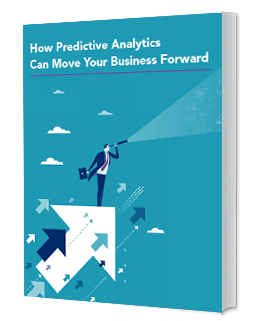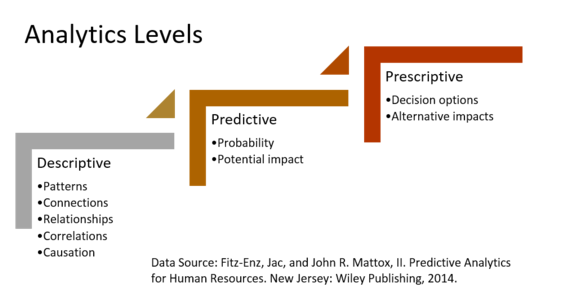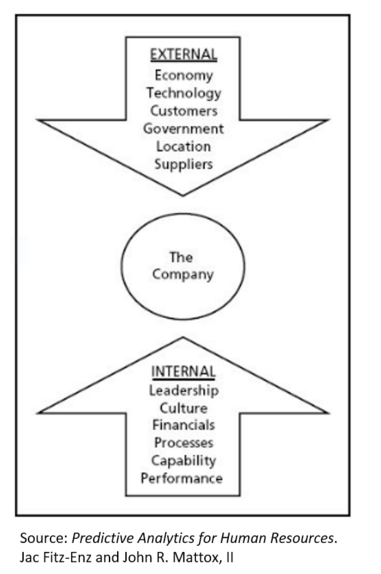
If you listen to analysts, pundits, and industry gurus, you might think you need to bet everything on human capital analytics today or your business will fail, maybe by next week. Well, maybe they are not all that gloomy, but we can all agree the shouting is loud and constant.
We agree that we should be investing in analytics, but we should learn to walk before we try to run a marathon. Most important, we need to realize that the transformation to advanced prescriptive analytics will take time, and sometimes the best approach is to start doing what we do now just a little bit better.
Why Human Capital Analytics is Important to your Business
Changes in business happen much faster than they did 25 years ago. The workforce you have today could be much different next year. Your people need to be constantly learning to keep up with technology changes.
There are many reasons why analytics is important, but these three are at the top of our list.
- Focus on value. People may be your largest expense, but their activities are also the source of your revenue. Machines, tools, and information by themselves do nothing to add value. Profitable activity happens when people interact with things and information. Even the most advanced robots do nothing until humans interact with them.
- Make Better Decisions Faster. As your analytics capability grows, you will predict workforce needs, estimate the outcome of workforce decisions, and evaluate alternatives before you implement them. At today’s speed of business, you need to act quickly and decisively.
- Get Off the Treadmill. Most of us spend much of our time fighting the same problems over and over. We don’t take the time to think. Advanced analytics won’t do our thinking for us, but it will organize information in ways that help us think better.
 Where to Start
Where to Start
In Predictive Analytics for Human Resources, Jac Fitz-Enz and John Mattox describe three levels of human capital analytics beyond simple reporting.

- Descriptive analytics examines historical data to evaluate connections, relationships, correlations, and causations.
- In Predictive analytics, we use past patterns to predict future patterns.
- Prescriptive analytics takes prediction to the next level by using complex data to predict alternative outcomes to optimize the workforce. For example, prescriptive analytics could not only tell you it would be profitable to enhance your onboarding program but might show long it should be and what it should include.
Almost all of the people we meet are just beginning to understand the first level. There is nothing wrong with that -- it is a great place to start. Most likely, if you have anything to do with people analytics, you are already tracking metrics that matter and are trying to influence them. That will be the foundation for your first steps.
Begin with Your Culture and Purpose
The first action in your plan should be to gain agreement and clarity on your organization’s culture and purpose. The reason is relatively straightforward. If your efforts do not align with your culture and purpose, you may succeed in the short term, but your efforts will lose momentum over time. Culture rules in every organization, and a company without a purpose beyond profit will be swallowed by competition.
As Yogi Berra said, “If you don't know where you are going, you'll end up someplace else.”
How to Get Started
You are beginning a long journey to useful prescriptive analytics. As your capability grows, so will your results. Even if you have not yet mastered predictive and prescriptive analytics, you will be able to learn enough in your first effort to make sound predictions based on your data.
We gleaned the following steps to success from our own experience and from Predictive Analytics for Human Resources.
Identify an Executive Sponsor. Your project needs a sponsor in the C-suite or closely allied with it. The ideal sponsor is the person accountable for the business result or KPI you want to affect. It should also be the person who can command the resources you will need. The best approach, in our experience, is to have a conversation with the sponsor about organizational performance and suggest how analyzing human capital could solve a problem.
Start Small. It is unlikely your business leaders are all on board with the expense and effort of implementing an all-out human capital analytics effort. The harsh truth is that most business leaders don’t trust HR data. Your success on a small project will begin to build trust and make a larger effort easier to sell. You will :
- add value to the business,
- establish the credibility that goes with return on investment, and
- begin the organizational development path for greater efforts.
Know Your Purpose. The most important activity in human capital analytics is asking questions relevant to your purpose. Some analysts will tell you it is best just to amass the data, apply algorithms, and “see what the data says.” We disagree with that approach. We use the same approach to analytics as we do in all our work -- first, know your purpose.
Identify your objective and its expected impact. Improving the time to productivity is a nice goal, but it means nothing unless you tie it to business results.
Assemble the Team. In addition to yourself and your sponsor, you will need team members who are competent in these areas:
- functional expertise,
- process management,
- project management, and
- data analytics, including data modeling and reporting.
You do not need to hire a gaggle of data scientists and build a data center. You can do well with a good consultant with experience in human capital analytics.
Know the Business. Analyze the internal and external influences affecting the business. You can use the simple model by Jac Fitz-Enz (right) or a more sophisticated tool like an Ishikawa diagram or interrelationship digraph. The understanding you develop will be essential to know what your data means to the business.
Organize the data. Clean up and organize your data, but don’t try to make it perfect. No one has perfect data, and you don’t need 100% accuracy to make good decisions. Your data only needs to be good enough to show relationships, trends, correlations, and causation.
Analyze the data. Show your data in reports and charts that you can compare. You likely have an Excel wizard in your organization who can do this.
Analyze the data to evaluate relationships, connections, correlations, and causation. Take care in assigning causation to correlations. Consider all the influences on each data point.
Implement your solution and measure the result. Quantify it in financial terms to show its impact on the business.
Tell the story. Using your quantified data, tell the story to your executive group. You sponsor can assist you in understanding how your executives want to hear the story.
Build Relationships and Trust
The larger purpose behind this effort is to build trust that your data has value and that it can be used to solve business problems. Small successes that improve business results will build credibility, and that will get you the support you will need to move on to the next level of analytics.
References
Pease, Gene, Boyce Byerly, and Jac Fitz-enz. Human Capital Analytics: How to Harness the Potential of Your Organization's Greatest Asset. Hoboken, NJ: Wiley, 2013.
Fitz-Enz, Jac, and John R. Mattox, II. Predictive Analytics for Human Resources. New Jersey: Wiley Publishing, 2014.
Pixentia is a full-service technology company dedicated to helping clients solve business problems, improve the capability of their people, and achieve better results.

